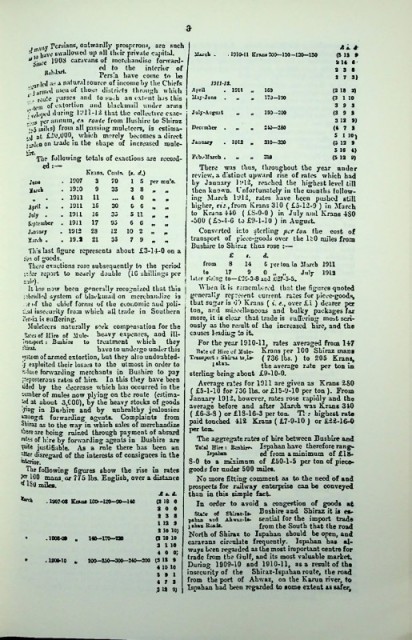Page 323 - 5 Persian Trade rep BUSHIRE I_Neat
P. 323
a
i \ny Persians, outwardly prosperous, arc such Ait
**r have swallowed up all their private capital. March . .1910-11 Krana 200-150-120—130 (8 13 9
*,,J 1903 caravans of merchandise forward-
iiuce 2 14 fl
cd to the interior of 3 3 8
RihJAri-
Persia have come to bo a 7 3)
led as a natural source of income by the Chiefs
l*j armed men of those districts through which April . 1911 ICO (2 18 2)
* route passes and to such an extent has this i ILij-Junc 170-190 (3 1 10
^,.,1 of extortion and blackmail under arms | 3 9 3
'■\t*K'l>eJ during 1911-1*2 that the collective cxac- Ju’j-Acjrast 190-200 (3 9 3
*,;uC per annum, cn route from Uushire to Shiraz 3 12 9)
jvj inihf) from all passing muleteers, is cstima- December 210—280 (4 7 3
vJ at £iU,000, which merely becomes a direct 5 1 10)
jirJcn on trade in the Bhape of increased mule- January . 1913 » 310—320 (5 13 9
5 16 4)
birc-
Thc following totals of exactions are record- Fcb.-March . 310 (5 12 9)
ed There was thus, throughout the year under
Kr.\ns. Cents, (r. d.) review, a distinct upward rise of rates which had
Jane . 1907 3 70 1 5 per mu’e. by Jauuary lt'12, reached the highest level till
Vvcb . 1910 9 35 3 8 „ „ then known. Unfortunately in the months follow
. 1911 11 4 0 n ing March 1912, rates have been pushed still
April . . 1911 16 30 6 C H r» higher, rifn>m Krans 310 ( £5-12-9 ) in March
. 1911 16 33 5 11 to Kruns 44-0 ( £8-0-0 ) in July and Krans 480
Joljr . 99
September . 1911 17 93 6 C 99 M -500 (£8-4-0 to £0-1-1U ) in August.
J^naarj . 1912 23 12 10 2 m Converted into sterling per ton the cost of
March . . 19.2 21 33 7 0 m „ transport of piece-goods over the lbO miles from
Bushire to Shiraz thus rose :—
This last figure represents about £3-14-0 on a
£ i.
r'on of goods. t.
Thc?e exactions rose subsequently to the period from 8 14 C per ton ia March 1911
zz-kr report to nearly double (1G shillings per to 17 9 0 „ July 1912
later rising to—£20-3-8 and .027-5-5.
rule).
It Las now been generally recognized that this j ^ hea it is remembered that the figures quoted
::bridled system of blackmail on merchandize is i generally represent current rates for piece-goods,
.e of the chief forms of the economic aud poll- that sugar is 00 Krans ( t. e., over £i ) dearer per
•Jjal iusecurity from which all trade in Southern ton, and miscellaneous and bulky packages far
iVr.-ia is suffering. more, it is clear that trade is suffering most scri-
Muleieers naturally seek compensation for the ously as the result of the increased hire, and the
Sites of Iliro of Mule- heavy expenses, and ill- causes leading to it.
Tracjport: Bushire to treatment which they For the year 1910-11, rates averaged from 147
fti702. have to undergo under this Kate c f Hire of Mulc- Krans per 100 Shi raz mans
'jstc-tn of armed extortion, but they also undoubled- Transport: Shins to.Is- ( 736 lbs. ) to 205 Krans,
•7 exploited their losses to the utmost in order to lalaa. the avenige rate per ton in
~«luie forwarding merchants in Bushire to pay sterling being about £9-10-0.
:reposteroas rates of hire. In this they have been Average rates for 1911 are given as Krans 250
uded by the decrease which ha3 occurred in the ( £5-1-10 for 736 lbs. or £15-9-10 per ton ). From
-umber of mules now plying on the route (estima- January 1912. however, rates rose rapidly and tho
^ at about 3,C00), by the heavy stocks of goods average before and after March was Krans 340
lying in Budiire and by unhealthy jealousies
( £6-3-3 ) or £18-16-3 per ton- T1 ; highest rat®
wrnngst forwarding agents. Complaints from paid touched 412 Kraus ( £7-9-10 ) or £22-16-0
Shiraz as to the way in which sales of merchandize
there are being ruined through payment of absurd per ton.
rites of hire by forwarding agents in Bushire are The aggregate rates of hire between Bushire and
Tute justifiable. As a rule there has been an Total Hire: Bahl^ Ispahan have therefore rang
Uter disregard of the interests of consignees in the lipahaa ed from a minimum of £1&-
^terior. S-0 to a miximum of £50-1-5 per ton of piece-
'Hie following figures show the rise in rates goods for under 500 miles.
?cr 100 mans or 775 lbs. English, over a distance No more fitting comment as to the need of and
* ISO miW prospects for railway enterprise can be conveyed
Jt *. d. than in this simple fact.
-1907-08 Ennm 1CO--120—90—140 (3 18 0 In order to avoid a congestion of goods at
3 0 0 Bushire and Shiraz it is es-
. , .
Slate of Sliiaz-I>-
,
.
. .
3 3 8 pabrn &ud Ahvu-U- sential for the import trad®
1 12 9 1 ahin Roala. from the South that the road
2 10 10)
North of Shiraz to Ispahan should be open, and
. 1908-09 . 140—179—239 (2 10 10 caravans circulate frequently. Ispahan has al
3 1 10 ways been regarded as the most important centre for
4 0 0)
-1900-10 * 200—250—300—240—200 (3 12 9 trade from the Gulf, and its most valuable market.
4 10 10 During 1909-10 and 1910-11, as a result of th®
3 9 1 insecurity of the Shiraz-Ispuhan route, the road
4 7 3 from the port of Ahwaz, on the Korun river, to
Ispahan had been regarded to some extent as safer,
.3« 9)

